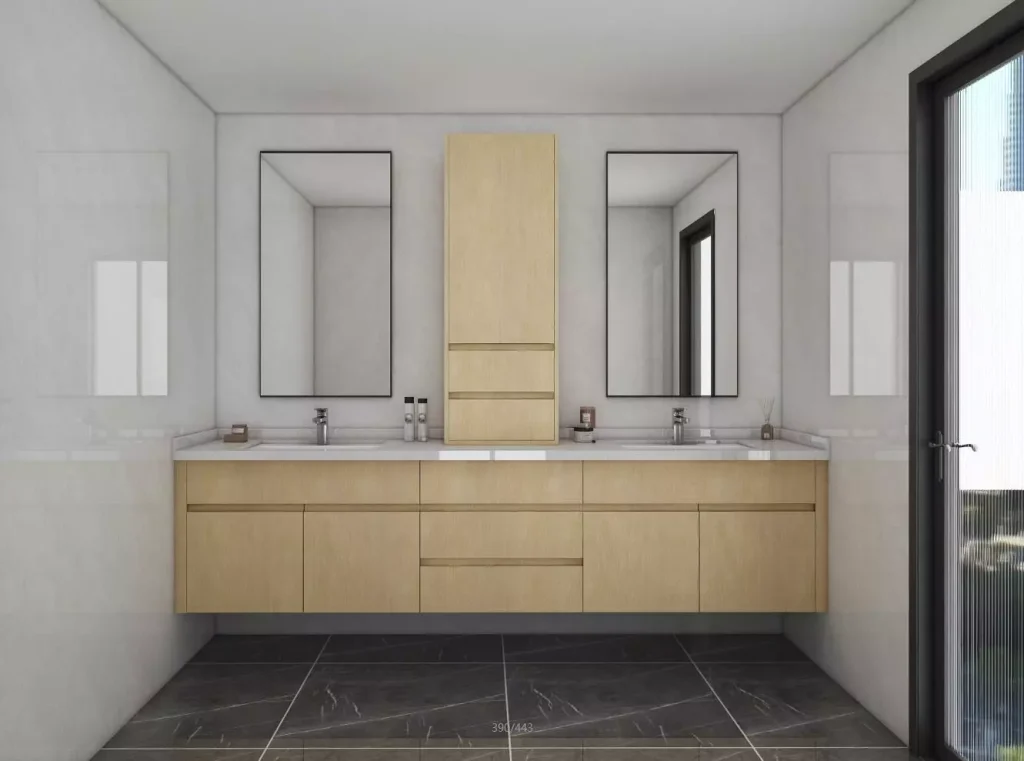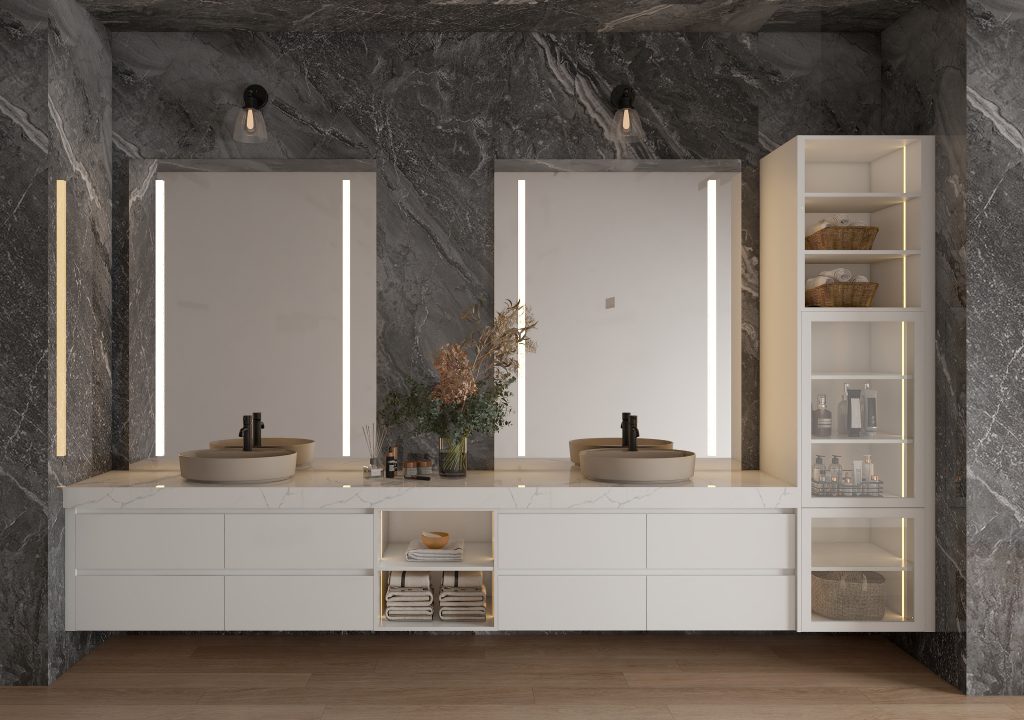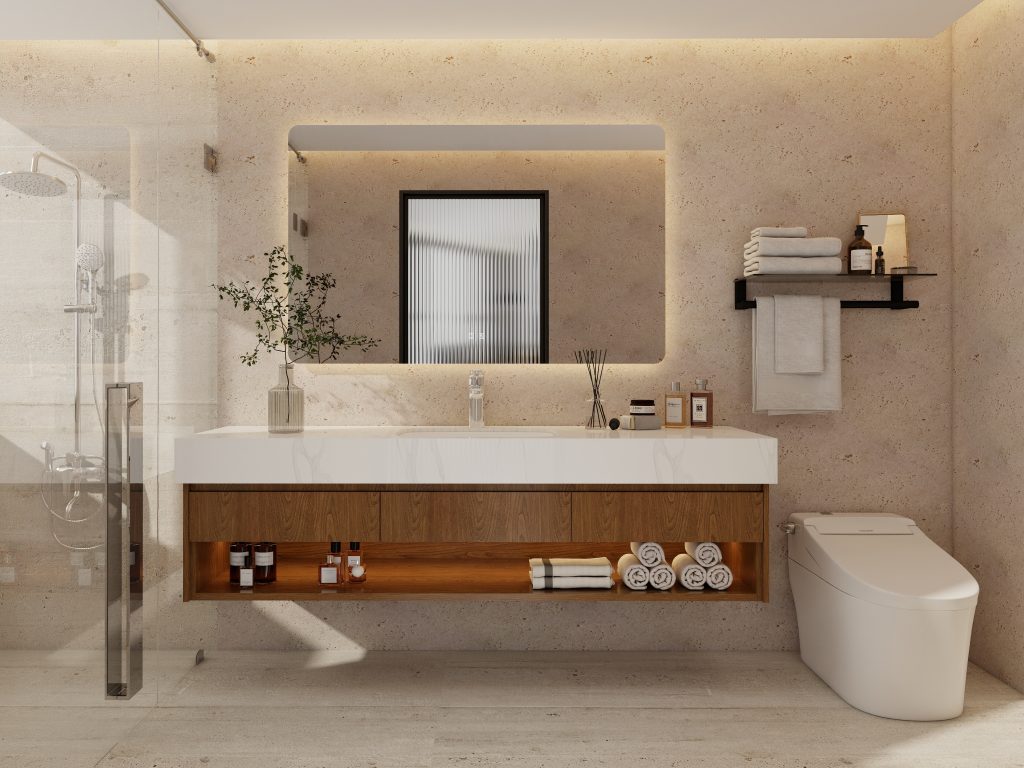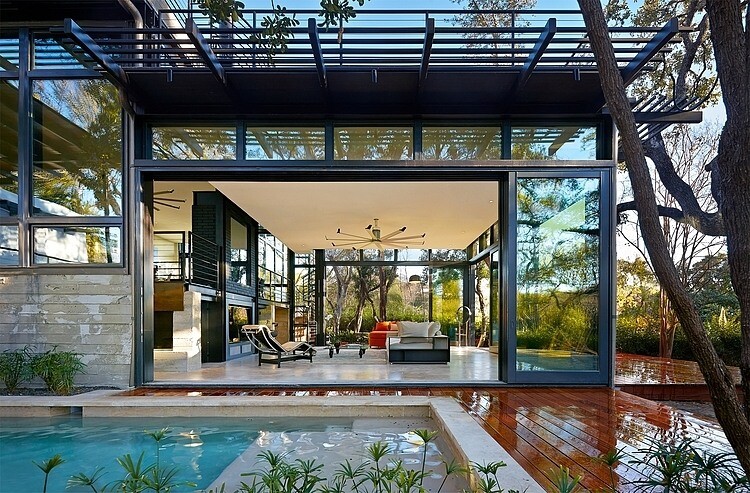Floating bathroom vanities are becoming a popular trend in modern bathroom design, known for their sleek, minimalist look and ability to create the illusion of more space. However, with so many options and considerations, it’s easy to get overwhelmed. In this article, we answer 11 essential questions about floating bathroom vanities to help you make an informed decision. Whether you’re remodeling your bathroom or building a new one, these insights will guide you through the pros, cons, installation tips, and design ideas for choosing the perfect vanity.
1. What is Floating Bathroom Vanities?
One modern design choice that has been growing in popularity in contemporary bathroom remodels is a floating bathroom vanity. Floating bathroom vanities differ from traditional vanities in that they’re mounted to the wall, leaving the floor space underneath exposed. This design makes the space appear larger, and it helps to give the bathroom a lighter, airier feel. These vanities create the illusion of space by eliminating bulky legs or floor-hugging cabinets, an advantage in a smaller bath.
These vanities can have a variety of styles and materials, making this versatile depending on your design preference. Whether your goal here is minimalism, industrial-style, or something of a more decadent variety, floating vanities will fit seamlessly into the aesthetic. One of their main benefits is the way they create an open space underneath, which makes cleaning a lot more manageable than with traditional vanities.
Not only do floating bathroom vanities add a sleek and modern appeal, they also offer a space-saving solution to your storage needs.

2. What Are the Pros of Floating Bathroom Vanities?
Space-Saving Design
Floating bathroom vanities not only come in all shapes and sizes, they also can create a sense of space. Mounting the vanity on the wall leaves the floor below open, which makes the room feel larger. This is especially useful for compact bathrooms, with every inch counting. It makes the room appear larger, not only because of less clutter, but also because of its easiness to get around in, allowing the space to flow better.
Hassle-Free Cleaning
A floating bathroom vanity cabinet makes cleaning much easier. Because the unit is elevated off the ground, there are fewer areas for dust, dirt or grime to stick. Maintaining it is done more easily since you can easily sweep or mop under the vanity without needing to bend over and reach into awkward corners. When it comes to low maintenance bathroom this is definitely an advantage.
Sleek and Modern Aesthetic
A floating bathroom vanity with glass top 30 inch brings a sophisticated, modern look to any bathroom. These vanities are often designed with clean lines and minimal forms to complement contemporary spaces. Adding a measure of elegance to both small and large bathrooms, their slim profile helps them blend right in while making the space feel higher end.
Pick Your Personalization
Floating bathroom vanities are highly customizable. From small floating bathroom vanity cabinet to large floating bathroom cabinet, you will find no limit of options to meet your desired requirement. There are a variety of materials and finishes to choose from, as well as sink styles, making sure that the vanitydesign matches the rest of your bathroom’s decor.
Enhanced Aesthetic Appeal
These vanities’ floating architecture immediately transforms the look of your bathroom. The vacant space under the bathroom floating vanity keeps the area, clean and airy looking and makes the area even more spacious. There’s also a variety of personalization features, allowing you to match the vanity with the theme of your bathroom, be it minimalist, modern, or more traditional. Spruce up the space even further by adding a few details underneath, such plants or storage baskets.

3. What Are the Cons of Floating Bathroom Vanities?
Floating bathroom vanities have a lot of advantages, but they also have some disadvantages that you should take into consideration before you purchase one.
Installation Complexity
Installing a floating vanity may be more difficult than traditional vanities. These need to be bolted to a solid wall as they need to carry the weight of the unit. This typically requires extra work and expense to install — particularly if the wall needs to be reinforced. Installation in certain situations is also non-negotiable, which can raise the total expense. Still, once correctly and professionally installed, the vanity can be very secure and resilient.
Limited Storage Options
Aside from saving floor space and giving you a neat bathroom, floating bathroom vanities are often smaller in terms of storage and closet than those at ground level. And, because they’re suspended above the floor, the storage compartments tend to consist of open shelving or space-saving drawers. This might not work well for those who require ample bathroom storage. So if you need to make room for toiletries, towels or cleaning products, you might have to buy more storage solutions elsewhere in the bathroom.
Durability Concerns
While sleek and modern, floating vanities may require more upkeep in high-moisture environments. Materials like wood, if not sealed properly, are prone to water damage and warping, especially in humid bathrooms. To ensure durability, opt for water-resistant materials and perform regular maintenance. For those seeking low-maintenance options, these may not be the best fit.
Higher Cost
Floating bathroom vanities tend to be pricier than traditional ones due to their modern design, premium materials, and complex installation. Though the initial cost is higher, the space-saving and stylish look can justify the investment for many homeowners.
In short, floating bathroom vanities offer style and functionality but come with challenges like higher costs, limited storage, and maintenance needs. Depending on your bathroom setup and priorities, the pros or cons may be more important to you.

4. How Do I Choose the Right Floating Bathroom Vanity for My Bathroom?
Selecting the right floating bathroom vanity is essential for maximizing both the functionality and aesthetics of your bathroom. Here are some tips on what to consider when making a decision:
Measure the Bathroom Space
Measure your bathroom’s size and the available wall space before you make any decisions. This ensures that the floating vanity you select will fit well and not overwhelm the space. Of course, small bathroom might benefit from compact vanities, but for larger bathrooms larger designs would fit well.
Storage Needs
If you’re a person who needs extra storage, look out for a floating bathroom vanity with drawers or open shelving. Some models have additional storage solutions, such as built-in cabinets or space under the sink, so think about what will best accommodate your needs for toiletries, towels and cleaning products.
Style Preferences
Floating vanities are available in a variety of styles. You can get a floating vanity that will match whether you want a minimalist look, a rustic charm, or a more elegant design. Reflect on the general aesthetic of your bathroom—are you leaning more modern, traditional, industrial? Select a vanity that matches that style.
Material Choices
The type of material your vanity is made of can have a significant effect on its look and longevity. If you’re looking for a natural and warm feel, wood is a good choice; if your design leans more toward industrial, perhaps metal is the way to go. Stone vanities, by contrast, add a luxurious feel. Ensure the material you select complements the coloration and layout of your bathroom.
Wall Considerations
Lastly, make sure there is wall load-bearing capacity if the floating vanity is attached with a sink or countertop. A proper support may be required for some designs of the wall. When in doubt, consulting a professional may be best to avoid issues with installation in the future.
If you keep these factors in mind, you are well on your way to selecting the perfect floating bathroom vanity perfect for your practical needs and design provisions.
5. How to Install Floating Bathroom Vanities?
With the proper tools and procedures, set up of a drifting washroom vanity can be an easy project. Use a level to ensure they’re level, then mark where they will set on the wall. Secure the vanity with heavy-duty anchors when drilling directly into the studs, particularly if it has a sink or countertop. After the brackets are installed, secure the vanity to the wall, checking that it’s level before tightening the screws.
If you are comfortable with some basic tools, this can be a DIY project. But if plumbing connections are involved or if you’re not confident in your ability to reinforce walls, it makes sense to hire a pro. Make sure the wall can carry the weight, and if the vanity has a sink, additional bracing may be required. Lastly, if your vanity has a built-in sink, build in plumbing hookups so you don’t have any leaks or drainage problems.
Following these steps closely will help you achieve a safe and working floating vanity installation.
6. What Materials Are Used in Floating Bathroom Vanities?
Widely, the materials are divided into countertop materials and cabinet materials. Different materials provide varying durability, maintenance requirements, and aesthetic value.
Countertop Materials
- Sintered Stone: Made by combining natural minerals and clay at high temperatures, sintered stone is scratch, stain, and moisture-resistant. It offers a sleek, modern look and comes in various colors and textures, making it ideal for bathroom countertops.
- Quartz: Composed of natural quartz crystals and resins, quartz is non-porous, durable, and resistant to stains and scratches. It requires minimal maintenance and is available in a wide range of designs to suit any bathroom style.
- Marble: Known for its luxurious appearance and veining, marble is heat and scratch-resistant but more porous, requiring regular sealing and maintenance, especially in humid bathroom environments.
- Artificial Stone: A mix of natural stone and resin, artificial stone is stain-resistant, low-maintenance, and affordable. It mimics natural stone with a uniform pattern, making it a popular choice for many homeowners.
- Ceramics: Made from clay fired at high temperatures, ceramic countertops are durable, easy to clean, and come in various colors. They’re a budget-friendly and stylish option for bathroom vanities.
| Material | Advantages | Disadvantages |
|---|---|---|
| Sintered Stone | - Extremely durable and scratch-resistant - Non-porous and resistant to stains - Heat resistant - Available in various styles |
- Can be expensive - Heavier than other materials, requiring additional support |
| Quartz | - Non-porous, easy to clean - Highly durable and scratch-resistant - Available in many designs - Low-maintenance |
- Can be costly - Less heat-resistant than natural stone - Not ideal for extreme temperatures |
| Marble | - Luxurious and timeless aesthetic - Unique veining patterns - Heat and scratch-resistant |
- Requires regular maintenance and sealing - Prone to staining and scratching over time |
| Artificial Stone | - Smooth, uniform surface - Low-maintenance and easy to clean - Affordable compared to natural stones |
- Less natural-looking than stone - Can be prone to discoloration over time |
| Ceramics | - Affordable and versatile - Easy to clean - Wide range of colors and designs |
- Less durable than other materials - Can crack or chip more easily |
Cabinet Materials
- Wood: Wood cabinets are classic and versatile, working with nearly any bathroom aesthetic. Hardwoods such as oak, walnut or maple are hardy and can be finished in numerous ways to suit a variety of decors. Wood is susceptible to moisture, so it can need more frills and upkeep to stay looking spiff over time, though.
- Aluminum: Aluminum cabinets are excellent if you desire a sleek, contemporary appearance. They are lightweight, rust-resistant, and low-maintenance. Aluminum also durability, which is a great choice for the bathroom where there is high humidity. It can scratch easily, though, and the metallic finish is not to everyone’s taste.
- Stainless Steel: Stainless steel cabinets have a modern, industrial vibe. They are very durable, rust-resistant, and simple to clean. It is also resistant to water, which makes it great for bathrooms. That said, it’s prone to fingerprints and smudges, meaning you’ll have to regularly clean it to ensure that it looks its best.
| Material | Advantages | Disadvantages |
|---|---|---|
| Wood | - Classic and timeless aesthetic - Durable and customizable - Can be finished to match various bathroom styles |
- Sensitive to moisture and humidity - Requires regular maintenance and sealing |
| Aluminum | - Lightweight and rust-resistant - Modern and sleek design - Low maintenance |
- Can scratch easily - Metallic look may not suit all bathroom styles |
| Stainless Steel | - Highly durable and rust-resistant - Contemporary, industrial look - Easy to clean and maintain |
- Shows fingerprints and smudges easily - Prone to scratches and denting in some cases |
7. Are Floating Bathroom Vanities Suitable for Small Bathrooms?
If you have a small bathroom, you can try floating bathroom vanities. It retains an open and airy feel, the exposed floor makes the room appear larger. This design trick really works in tight spaces where you are wanting to achieve as much square footage as possible.
When choosing a floating vanity for a small bathroom, look for designs that won’t overwhelm the space. Even light-colored materials, such as white or pale wood, can amplify that sense of openness. If saving space is a priority, search for vanities that have vertical storage capabilities or ones with shelves under the unit. So you can still keep the essentials without hogging valuable floor space.
In conclusion, since floating bathroom vanities offer style paired with functionality, Floating bathroom vanities are best suitable for small bathrooms. They lend a modern touch while preserving a sense of space.
8. How Much Do Floating Bathroom Vanities Cost?
The cost of floating bathroom vanities can vary widely depending on the design, material, and size. Here’s a breakdown of what you can expect to pay:
Budget Range: If you’re looking for a basic, budget-friendly floating vanity, prices typically start from $100 and can go up to $500. These are usually simpler designs with minimal features.
Mid-Range: For a well-designed vanity that offers more functionality, such as extra storage or better materials, expect to pay between $500 and $1,500. These vanities strike a balance between cost and quality.
High-End: Luxury floating vanities, often made from premium materials like marble or custom designs, can set you back over $2,000. These are perfect for those who want a stylish and high-end bathroom.
Floating bathroom vanities come in a variety of price ranges. Whether you’re on a tight budget or looking for something more luxurious, you’ll find a floating vanity to suit your needs and preferences.
9. How Do I Maintain a Floating Bathroom Vanity?
Floating bathroom vanity are low-maintenance but it is important to maintain it so that it can last more for years. Here are a few tips to keep it in optimal working order:
- Regular Cleaning: Wipe the surfaces with a gentle cleaner suitable for the material. So if you have wood vanities, use wood polish, and if you have marble or quartz use stone cleaner.
- Best Avoided Water Damage: Water is the using floating vanities, particularly for timber. Be sure to clean up spills quickly, since moisture can warp or stain.
- Inspect Mounting: Because floating vanities get mounted to the wall, inspecting the mounting brackets or wall anchors every couple months is always a wise move. This provides stability and security for the vanity.
Protective Coatings apply sealants, or protective coatings can extended the life-span, and keep the material moisture-proof. This is especially vital for materials like wood, which can be susceptible to scratches and stains.
10. Are Floating Bathroom Vanities Eco-Friendly?
Yes, many floating bathroom vanities are designed with sustainability in consideration. Here’s how they help support an environmentally conscious lifestyle:
- Eco-Friendly Materials: Numerous vanities are constructed from reclaimed wood or alternate sustainable materials, lessening the burden on forests and natural environments. Selecting a vanity constructed from recycled or sustainably produced materials, for example, adds a hand in eco-friendly production.
- Energy Saving Pill Manufacturing: Some kites manufacture wing using energy conservation process. They include consuming less energy during the production phase and minimizing waste through smart design and materials. You want to select brands that are focused on minimizing their impact on the environment.
- Enduring Durability: Quality floating vanities are built to stay. Vanities that run for a longer time require less replacements, thus reducing waste in the long run. Choose durabeibility; your eco-friendly bathroom will thank you.
Choosing a floating vanity constructed using sustainable material and supporting companies that focus on energy-efficient practices means making an eco-friendly choice without sacrificing style or function.
11. Where Can I Buy Floating Bathroom Vanities?
If you’re in the market for a floating bathroom vanity, there are plenty of ways to find the perfect one for your space, whether you prefer shopping online, in-store, or even through custom design options.
- Online Retailers: Websites like Wayfair, Amazon, and Overstock offer an extensive selection of floating bathroom vanities, with customer reviews and detailed product descriptions to guide your decision-making process.
- Home Improvement Stores: Physical stores or specialized bathroom retailers let you view vanities in person, giving you the chance to examine materials, finishes, and sizes before purchasing.
- Custom Design: For a unique, tailored look, you can work with contractors or designers who can create a custom floating vanity that perfectly fits your bathroom’s layout and style preferences.
- Chinese Imports: Brands like PA Home, a leading Chinese manufacturer, offer high-quality floating bathroom vanities at competitive prices. Their customizable options and durable materials make them a great choice for anyone looking to enhance their bathroom with space-saving, stylish designs.

Whether you choose online shopping, visiting a store, custom designs, or looking into Chinese imports, you’ll find a floating bathroom vanity that fits your style, needs, and budget.
Conclusion
Now that you have answers to the most common questions about floating bathroom vanities, it’s time to decide if this modern design is right for you. If you’re ready to transform your bathroom, consider incorporating a floating vanity into your next remodel. Want to explore more design options or need help choosing the best materials? Get in touch with a design expert to bring your dream bathroom to life!
FAQS
1. Are floating vanities suitable for all bathroom styles?
Yes, floating vanities are versatile and can complement various bathroom styles, from modern and minimalist to industrial or spa-inspired designs. With different materials and finishes, they can fit into both contemporary and traditional bathroom settings.
2. Do floating bathroom vanities require special plumbing?
Floating bathroom vanities with integrated sinks might require specific plumbing adjustments, such as rerouting the drain or adjusting the water supply lines. If you’re installing a vanity with a sink, it’s advisable to consult a plumber to ensure proper plumbing connections.
3. What are the storage options for a floating bathroom vanity?
While floating vanities may have limited storage compared to traditional vanities, many designs come with built-in drawers or shelves for storing bathroom essentials. If more storage is needed, you can opt for a floating vanity with additional cabinets or integrate storage solutions like wall-mounted shelves.


